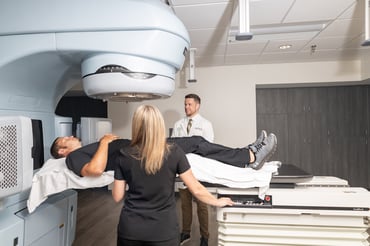
External beam radiation therapy is commonly used to treat many different types of cancer. For some, it’s the primary treatment used with or without surgery. For other patients, it’s used as one of several treatment therapies over the course of a plan that may include chemotherapy, immunotherapy, targeted therapy and/or hormone therapy.
There are a few types of cancer treatment that were developed specifically for certain types of cancer. These are Stereotactic Radiation Therapy (SRT) and Stereotactic Body Radiation Therapy (SBRT).
While all radiation therapy today is highly focused on delivering radiation to the exact location of the tumor, these technologies add an extra layer of precision for patients with certain types of cancer.
How is Stereotactic Radiation Therapy (SRT) Used?
Stereotactic Radiation Therapy (SRT) is a type of radiation therapy that uses advanced imaging techniques to deliver a high dose of radiation to a small area of the body, typically in the brain.
The goal of SRT is to precisely target cancer cells while sparing the surrounding healthy tissue. This is especially critical when treating sensitive organs such as the brain.
You might also hear about Stereotactic Radiosurgery (SRS). These are similar but are not exactly the same. Both are used for highly precise radiation delivery. SRS delivers a high dose of radiation to the tumor in a single day. SRT breaks down the dose over the course of several days. SRT allows more radiation to be given than what can be used in a single SRS dose.
Because the radiation is being delivered to a very precise and sensitive area of the body, radiation oncologists will typically require a mask or “mold” be created during the simulation phase to place over the patient’s head during each treatment. This keeps the patient in the correct position during each session making it possible to target the exact same location each time treatment is given.
What is Stereotactic Body Radiation Therapy (SBRT)?
Stereotactic Body Radiation Therapy (SBRT) is also a highly precise external beam radiation therapy. It’s used most often for soft tissue cancers including the lungs, liver, pancreas, and prostate. The radiation is delivered using a linear accelerator that sends multiple beams of radiation at various angles so that the tumor is very carefully targeted rather than other nearby organs or tissue. Most patients receive this high dose of radiation over the course of a few days rather than a few weeks compared to other types of external beam radiation therapy.
The right type of radiation therapy is determined by the team at the cancer center as they consider the patient’s health history, type of cancer, location, and stage.
Before each SBRT session, patients usually have images taken to be sure the tumor hasn’t moved due to breathing or the body’s regular motion. Because this is a very high dose of radiation, these images will help guide the radiation oncologist in making sure the beams are focused on the current location of the tumor.
Advantages of SRT and SBRT Compared to Other Radiation Therapy Treatments
SRT and SBRT offer several advantages over traditional radiation therapy techniques and even over other surgery techniques. These include:
- Precise tumor targeting: SRT and SBRT use advanced imaging techniques to precisely target cancer cells while sparing healthy tissues.
- Shorter total treatment time: SRT and SBRT are typically complete in 1 - 5 total sessions. Other types of radiation therapy can be 3-5 weeks of daily sessions if hypofractionated radiation therapy is used. Or it can be longer if hypofractionated radiation is not an option.
- Fewer side effects: SRT and SBRT are associated with fewer side effects than traditional radiation therapy, which can improve the patient's quality of life during and after treatment.
Another advantage can be the success rate of SRT and SBRT. Studies show that these therapies are more effective compared to conventional radiation therapy when it comes to looking at the patient survival rates. UCLA states that the two-year results of SRT and SBRT have an 80-90% success rate compared to a 30-40% two-year success rate of other radiation therapies. This is still being researched extensively to be sure that we update our treatment plans with those therapies proven to be most effective.
What is SRT/SBRT Treatment Like?
When receiving stereotactic radiation therapy (SRT) or stereotactic body radiation therapy (SBRT), patients can expect the following:
- Planning session: Before the treatment begins, patients will have a planning session where they will undergo imaging scans, such as CT or MRI scans, to help the radiation oncologist determine the size, shape, and location of the tumor. The radiation oncologist will also use this session to design a customized treatment plan that delivers precise radiation doses to the tumor while sparing nearby healthy tissues. Other specialists such as a medical physicist work together to form the precise plan for each patient. This is also the time when a mold may be made so that you are placed in the exact same position for each treatment.
- Treatment sessions: During the treatment sessions, patients will lie on a treatment table while the radiation machine delivers highly precise radiation beams to the tumor. The treatment session typically lasts between 30 minutes to an hour, but this can vary depending on the size and location of the tumor. Wear comfortable, loose clothing that you can move around in.
- Side effect management: Side effects of SRT and SBRT are typically mild and temporary. But you may want to have some things on hand to help you manage issues such as irritated skin which can be soothed with a good moisturizer or aloe vera – similar to how you would treat a sunburn. You might also feel fatigued, even if you had a good night’s sleep. Let your body rest as much as you can so you can focus on healing. If you are receiving SRT for a brain tumor, you might also experience some headaches or blurry vision. This should pass but talk to your radiation oncology team about anything you notice.
- Follow-up appointments: After the treatment is complete, patients will need to follow up with their radiation oncologist for regular check-ups to monitor the response of the tumor and to manage any side effects that may arise. This may be in addition to your appointments with the medical oncologist and/or surgeon who will remove the cancer.
It's important to note that the specific treatment experience can vary depending on the type of cancer being treated, the patient's individual health status, and the specific treatment plan designed by the radiation oncologist.
Do SRT and SBRT Have Side Effects?
SRT and SBRT cause few side effects, and many patients have no problems. If there are side effects, they’re usually short-term and can include the following:
- Skin irritation, tenderness, or dryness at the treatment site
- Short-term headache, especially if treatment is in the head or neck area
- Stomach upset which could include nausea and/or vomiting
- Diarrhea
- Dizziness
- Soreness from the immobilization device or from lying still on the table for a period of time.
Your oncologist can help you understand what to expect and when to reach out for extra assistance based on the side effects.
Rarely, a patient may develop seizures, brain swelling, or problems with speech, memory, or reasoning. Long-term risks can include bone weakness/fractures, damage to healthy cells, developing second cancer, and lymphedema (swollen arms or legs). Rarely, side effects can start months or years after treatment ends.
Latest Stereotactic Radiation Treatments Are Available in the Atlanta Area
Stereotactic Radiation Therapy (SRT) and Stereotactic Body Radiation Therapy (SBRT) are available in the greater Atlanta area. Talk with a radiation oncologist about what is available to you based on the type of cancer, stage, and location.
Request a consultation at a location near you for a personalized treatment plan. Our team will work closely with the medical oncologists and surgeons who may also be part of your cancer treatment process.

